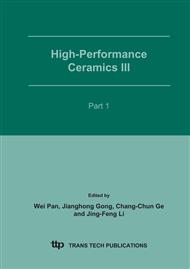p.1647
p.1651
p.1655
p.1659
p.1663
p.1667
p.1671
p.1675
p.1679
Study on Corrosion Mechanism of CAS Glass-Ceramic to Refractories by EPMA
Abstract:
CaO-Al2O3-SiO2 (CAS) glass-ceramic is a novel material developed in recent years. It has a number of excellent properties, such as shining appearance, high strength, and good erosion resistance. So its practical prospect is wide. Many glass and ceramic scientists have studied this glass-ceramic, but there have been no publication made regarding corrosion mechanism. In order to choose the most suitable refractory materials for melting furnace for this glass-ceramic system, the corrosion and erosion mechanism must be investigated. The results can then be used to design the furnace and predict the life of the melting furnace. Also such investigation will reveal the extent of contamination of the final glass-ceramic product. According to the experiment that the glass liquid corrodes refractory materials in static condition, various effective material test method were used, especially Electron Probe Microanalysis (EPMA). Using EPMA, the chemical species, morphology, size and distribution of refractory materials corroded can be observed, so we know the microstructure of refractory materials prior to and after being corroded as well as the features of changing. In this paper, the authors present the features of refractory materials microstructure prior to and after being corroded by means of analyzing these pictures, which is very useful to provide the reliable theory to establish the mechanism that CAS glass-ceramic liquid corrodes the refractory materials.
Info:
Periodical:
Pages:
1663-1666
Citation:
Online since:
February 2007
Authors:
Keywords:
Price:
Сopyright:
© 2005 Trans Tech Publications Ltd. All Rights Reserved
Share:
Citation:


